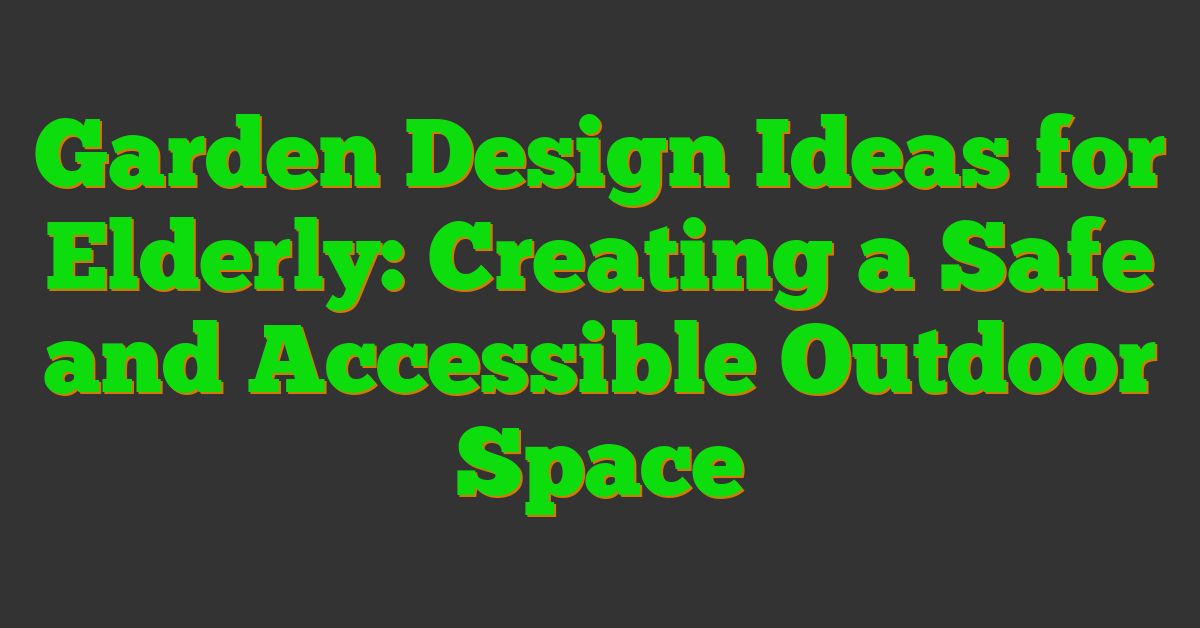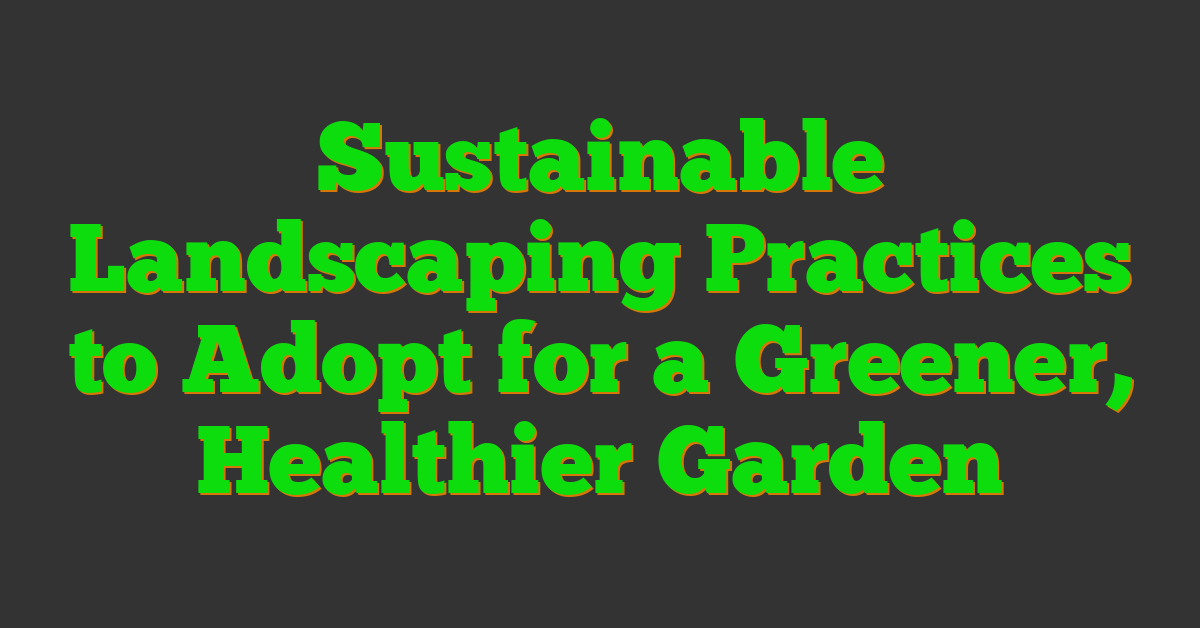Gardening can be a fun and rewarding activity for people of all ages, including seniors. However, as we age, we may face physical limitations that can make gardening more challenging. With a few simple modifications and design choices, you can create a garden that is safe, comfortable, and enjoyable for elderly individuals.

Planning Your Garden Layout is an essential first step in creating a garden that is accessible and easy to navigate. Consider using raised beds or container gardening to reduce the need for bending and kneeling. Ensure that pathways are wide enough for walkers or wheelchairs and that they are free of tripping hazards. You may also want to include comfortable seating areas to rest and enjoy the garden.
Garden Safety and Comfort should be a top priority when designing a garden for seniors. Avoid using chemicals or pesticides that can be harmful to health, and ensure that all tools and equipment are easy to handle and lightweight. Adequate lighting is also essential for safety, particularly if the garden will be used in the evening or early morning. By taking these precautions, you can create a garden that is both safe and comfortable for elderly individuals.
Key Takeaways
- Planning your garden layout is essential to create an accessible and easy-to-navigate garden.
- Garden safety and comfort should be a top priority when designing a garden for seniors.
- Raised beds, container gardening, comfortable seating areas, and adequate lighting are all essential elements of a senior-friendly garden.
Planning Your Garden Layout

https://www.youtube.com/watch?v=C2UA8JueEL4&embed=true
Designing a garden for the elderly requires careful planning to ensure that it meets their unique needs and preferences. Here are some tips to help you create a garden that is both beautiful and functional.
Assessing Space and Mobility Needs
The first step in planning your garden layout is to assess the available space and your mobility needs. Consider the size and shape of your garden and how much time and effort you can devote to maintaining it. If you have limited mobility or use a wheelchair, make sure that your garden has flat surfaces and wide paths or walkways that are easy to navigate. You may also want to incorporate ramps or gradual gradients to make it easier to move around.
Choosing the Right Plants
Choosing the right plants is essential for creating a garden that is easy to maintain and enjoyable to look at. Opt for low-maintenance plants that require minimal watering and pruning, such as succulents, lavender, and rosemary. Consider planting a mix of perennials and annuals to ensure that your garden looks beautiful throughout the year. If you have allergies or sensitivities, be sure to choose plants that are not likely to trigger your symptoms.
Incorporating Accessibility Features
Incorporating accessibility features into your garden design can make it easier for you to enjoy your outdoor space. Consider adding handrails, raised garden beds, and seating areas throughout your garden. You may also want to install pathway lighting to help you navigate your garden at night.
Creating Zones for Activity and Relaxation
Creating distinct zones for different activities can help you make the most of your garden space. Consider designating areas for gardening, relaxation, and socializing. A shaded seating area can provide a comfortable spot to read or chat with friends, while a raised garden bed can allow you to tend to your plants without bending over.
By following these tips, you can create a garden that is both beautiful and functional, and that meets your unique needs and preferences.
Garden Safety and Comfort
https://www.youtube.com/watch?v=VwlC3ht2t54&embed=true
Creating a safe and comfortable garden is essential for elderly individuals. Here are some tips to help you ensure that your garden is a safe and comfortable place to spend time in.
Ensuring Safe Walkways and Paths
The first step in creating a safe garden is to ensure that all walkways and paths are safe and easy to navigate. This is especially important for elderly individuals who may have mobility issues. Make sure that all paths are level and free of any obstacles, such as rocks or tree roots. You may also want to consider adding non-slip materials to your walkways and paths to prevent slips and falls.
Selecting Non-Slip Materials
When selecting materials for your garden, it’s important to choose non-slip materials whenever possible. This includes materials for your walkways and paths, as well as any seating options you may have in your garden. Non-slip materials will help to prevent slips and falls, which can be especially dangerous for elderly individuals.
Adding Handrails and Seating Options
Handrails and seating options are essential for creating a comfortable and safe garden for elderly individuals. Handrails can be added to walkways and paths to provide support and stability for those with mobility issues. Seating options, such as benches or chairs, should be placed throughout the garden to provide a place to rest and relax.
Adequate Lighting for Evening Enjoyment
Finally, adequate lighting is essential for creating a safe and enjoyable garden for elderly individuals. Make sure that all walkways and paths are well-lit to prevent trips and falls. You may also want to consider adding lighting to any seating areas or other areas of the garden that you want to enjoy in the evening.
By following these tips, you can create a safe and comfortable garden that is perfect for elderly individuals.
Raised Beds and Container Gardening

Gardening is a fun and rewarding activity for people of all ages, but it can be especially beneficial for seniors. Raised beds and container gardening are two great options for elderly gardeners, as they are easier to manage and maintain than traditional garden beds.
Benefits of Raised Garden Beds
Raised garden beds offer several benefits compared to traditional gardening. They provide better soil drainage and aeration, which can lead to healthier plants and higher crop yields. They are also easier to access for elderly people or those with mobility issues, as they can be built at a comfortable height and don’t require bending or kneeling.
In addition, raised garden beds can be customized to fit any space or style. They can be built in a variety of shapes and sizes, and can even be designed to fit on a balcony or rooftop. Plus, they can be filled with high-quality soil and compost, which can help plants grow stronger and healthier.
Choosing Containers for Ease of Reach
Container gardening is another great option for seniors, as it allows for easy mobility and flexibility. Containers can be moved around as needed, and can be placed at a comfortable height for easy access. They also come in a variety of sizes and styles, so you can choose the perfect container for your needs.
When choosing containers for your garden, look for options that are lightweight and easy to move. You may also want to consider using containers with wheels or casters, which can make moving them even easier. In addition, look for containers with wide openings and shallow depths, as these will be easier to reach into and tend to.
« How Much Does a Landscaping Company Make? A Friendly Guide to Understanding Landscaping Business Earnings Does Landscaping Require a Permit? A Friendly Guide to Navigating Local Regulations »
Best Plants for Raised Beds and Containers
When planning your raised bed or container garden, it’s important to choose plants that are well-suited for your space and needs. Vegetables like tomatoes, lettuce, and peppers are great options for raised beds, as they require plenty of space and sunlight. Herbs like basil, thyme, and parsley are also well-suited for container gardening, as they can thrive in smaller spaces.
In addition, consider using mobility aids like garden beds with wheels or rolling garden seats to make gardening even easier. These tools can help you move around your garden more easily, and can provide a comfortable place to sit while you tend to your plants.
Overall, raised beds and container gardening are great options for seniors who want to enjoy the benefits of gardening without the physical strain. With a little planning and preparation, you can create a beautiful and productive garden that will bring you joy for years to come.
Sensory Stimulation in the Garden
https://www.youtube.com/watch?v=M8qnGKbdVJE&embed=true
Gardening is an excellent way to stimulate the senses, and it can be especially beneficial for elderly individuals. You can create a sensory garden that engages all the senses, including sight, smell, touch, taste, and sound. Here are some ideas to help you incorporate sensory stimulation in your garden.
Incorporating Color and Fragrance
Color and fragrance are two essential elements of a sensory garden. You can use a variety of plants to create a colorful and fragrant garden. Some plants that are known for their fragrant blooms include gardenias, jasmine, and lavender. You can also use herbs like rosemary, thyme, and basil to add fragrance to your garden.
When selecting plants for your sensory garden, consider using plants with different leaf colors and textures. For example, you can use plants with variegated leaves, such as hostas, to add interest and color to your garden.
Textures and Sounds for a Rich Experience
Textures and sounds are also important elements of a sensory garden. You can use plants with different textures, such as lamb’s ear, to create a tactile experience. You can also incorporate different sounds into your garden by adding wind chimes or a small water feature.
Attracting Wildlife for Observation
Attracting wildlife to your garden can also be a great way to stimulate the senses. You can plant flowers that attract butterflies and hummingbirds, such as zinnias and salvia. You can also add bird feeders and birdhouses to your garden to attract a variety of birds.
If you or someone in your household has vision impairment, consider using plants with interesting textures, such as those with rough bark or fuzzy leaves. You can also use plants with strong fragrances, such as mint or thyme, to stimulate the sense of smell.
In conclusion, a sensory garden can be a great way to stimulate the senses and create a relaxing and enjoyable outdoor space. By incorporating color, fragrance, textures, sounds, and wildlife, you can create a garden that engages all the senses and provides a rich experience for everyone to enjoy.
Adaptive Gardening Techniques
https://www.youtube.com/watch?v=I8tqT8Z5_x8&embed=true
Gardening is a rewarding activity for people of all ages, but it can become challenging as you get older. Fortunately, there are many adaptive gardening techniques that can help you continue to enjoy gardening even if you have physical limitations. Here are some ideas to get you started:
Ergonomic Tools for Comfortable Gardening
Arthritis and other conditions can make it difficult to grip and hold gardening tools. To make gardening more comfortable, look for lightweight tools with ergonomic handles. These tools are designed to reduce strain on your hands and wrists, making it easier to work in the garden for longer periods of time.
Easy Access to Water and Gardening Supplies
Having easy access to water and gardening supplies can make a big difference in your ability to garden comfortably. Consider installing a drip irrigation system to make watering your plants easier. You can also set up a potting bench or storage area near your garden to keep your tools and supplies within easy reach.
Gardening with Physical Limitations
If you have physical limitations, there are still many ways to enjoy gardening. Consider using a mobility aid, such as a walker or wheelchair, to help you move around the garden more easily. You can also use raised garden beds to reduce the need for bending and kneeling. Additionally, consider planting in containers or using vertical gardening techniques to make it easier to reach your plants.
By using these adaptive gardening techniques, you can continue to enjoy gardening even as you age. Remember to listen to your body and take breaks as needed to avoid overexertion. Happy gardening!
Choosing the Right Plants
https://www.youtube.com/watch?v=dslGiINx6IY&embed=true
When designing a garden for an elderly person, it’s important to choose plants that are low-maintenance, safe, and provide shade and shelter. Here are some tips to help you select the right plants for your garden.
Selecting Low-Maintenance Plants
Low-maintenance plants are a great choice for elderly gardeners who may not be able to spend a lot of time tending to their garden. Native plants, such as magnolias and grevilleas, are a good option because they are adapted to the local climate and require minimal care. Citrus trees are also a good choice, as they are easy to grow and provide fresh fruit.
Avoiding Plants That Pose a Risk
When selecting plants for an elderly person’s garden, it’s important to avoid plants that pose a risk. Plants such as azaleas and belladonna are toxic if ingested and can be dangerous if touched. Bamboo is also a plant to avoid, as it can spread quickly and become invasive.
Plants That Provide Shade and Shelter
Plants that provide shade and shelter are important for creating a comfortable and inviting garden space for elderly gardeners. Trees such as magnolias and citrus trees provide shade and can be a great place to sit and relax. Climbing plants such as ivy and wisteria can also provide shade and shelter, as well as add visual interest to the garden.
In summary, when designing a garden for an elderly person, it’s important to choose low-maintenance plants that are safe and provide shade and shelter. Native plants, citrus trees, and climbing plants are all great options to consider. Avoid toxic plants such as azaleas and belladonna, as well as invasive plants like bamboo.
Professional Assistance and Resources
https://www.youtube.com/watch?v=rcUgyIpB3lc&embed=true
If you’re considering a major garden redesign, you may want to work with a landscape architect or designer who specializes in designing gardens for seniors. These professionals can help you create a garden that is not only beautiful but also functional and safe.
Working with a Landscape Architect
A landscape architect can help you design a garden that is tailored to your specific needs and preferences. They will work with you to create a plan that takes into account your mobility limitations, such as the need for wheelchair access or the need for low-maintenance plants. They can also help you choose plants that are appropriate for your climate and soil conditions.
Finding Garden Design Inspiration
If you’re looking for inspiration for your garden design, there are many resources available. You can find garden design books at your local library or bookstore, or you can search online for garden design ideas. Many websites offer free garden design plans and ideas, as well as tips for creating a garden that is safe and accessible for seniors.
Community Resources for Elderly Gardeners
If you’re looking for community resources to help you with your garden, there are many organizations that can help. Your local senior center may offer gardening classes or workshops, and there may be community gardens in your area where you can rent a plot of land to grow your own vegetables and flowers. Additionally, there may be gardening clubs or groups in your area that you can join to connect with other gardeners and share tips and ideas.
Remember, designing a garden that is safe and accessible for seniors may require some extra effort, but the result will be a beautiful and functional space that you can enjoy for years to come.
Frequently Asked Questions
https://www.youtube.com/watch?v=BhHqm6xRoeQ&embed=true
What are some low maintenance garden ideas suitable for seniors?
As we age, it can become more difficult to maintain a garden. Luckily, there are many low maintenance garden ideas that are perfect for seniors. Consider using robust, low maintenance materials such as gravel or paving stones for your garden paths. Choose low maintenance plants such as succulents or native plants that require less watering and upkeep. Raised garden beds can also be a great option as they require less bending and kneeling to tend to your plants.
How can outdoor spaces be designed to be senior-friendly?
When designing outdoor spaces for seniors, it’s important to consider their accessibility and safety. A few things to consider are adding ramps rather than steps where possible, providing multiple spots to shelter from sun, wind, and rain, and adding handrails to provide support. You can also provide sitting areas throughout the garden to allow for rest and relaxation.
What are the best ways to simplify gardening for the elderly?
Gardening can be a great activity for seniors, but it can also be physically demanding. To simplify gardening for the elderly, consider using raised garden beds to reduce the need for bending and kneeling. Use lightweight tools with padded handles to reduce strain on the hands and joints. You can also use a gardening stool or bench to make gardening more comfortable.
How can one create a dementia-friendly garden environment?
Creating a dementia-friendly garden environment involves designing a space that is calming and easy to navigate. Use bright colors and sensory elements such as wind chimes or bird feeders to stimulate the senses. Consider using plants with a variety of textures and scents to create a multi-sensory experience. Avoid using plants with thorns or other sharp elements that could be dangerous.
What therapeutic benefits does gardening offer to seniors?
Gardening has been shown to have many therapeutic benefits for seniors. It can help reduce stress, improve mood, and provide a sense of purpose. It can also improve physical health by providing exercise and fresh air. Gardening can also be a great way to socialize and connect with others.
Are there any gardening programs or services aimed at helping seniors with gardening?
Yes, there are many gardening programs and services aimed at helping seniors with gardening. Local community centers or senior centers may offer gardening classes or workshops. There are also many organizations that provide gardening assistance to seniors such as the National Gardening Association’s Garden to Table program. Additionally, there are many volunteer organizations that provide gardening assistance to seniors in need.










